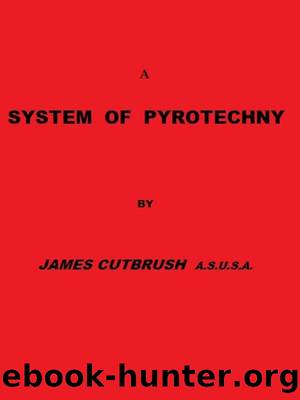A System of Pyrotechny Comprehending the theory and practice, with the application of chemistry; designed for exhibition and for war. by James Cutbush

Author:James Cutbush [Cutbush, James]
Language: eng
Format: epub
Tags: Fireworks, Military fireworks
Published: 2015-03-21T00:00:00+00:00
Cotton, 50 lbs.
Meal-powder, 30 lbs.
Vinegar, 12 galls.
Brandy, 7 galls.
Gum arabic, 2 lbs.
Camphor, 1 lb.
* * *
CHAPTER VI.
OF THE FURNITURE, OR DECORATIONS FOR FIRE-WORKS.
By the term garniture, used by the French, we understand the furniture, equipage, embellishments, or decorations for sundry fire-works, as rockets, bombs, batteries, fire-pots, &c.
Sec. I. Of Serpents.
The directions, given for the formation of serpents, are the same in Morel and Bigot. Paper is rolled lengthwise on a mandril, or form, which is a quarter of an inch in diameter, of three thicknesses, according as it is stout, and the last turn of the paper is pasted. They are made tight and strong, and strangled first at one end. They are then put upright in a square or round box, called a bushel, for the purpose of charging them. For this end we must have a small mallet, and a rammer of brass, of a smaller diameter than the form. The composition is put in and rammed, proportioning the number and force of the blows to the size of the case. The petard is formed, with extremely fine powder, then rammed, and the case choaked. To prime them, we open the ends with a piercer, and by means of a spatula introduce a portion of priming paste, or priming powder, in order that the fire may communicate.
We may here remark, that large cases for serpents, as well as wheel cases, are driven solid. There is usually a mould, in which is a nipple, with a point at top, that serves, when the case is filling, to stop the neck, and prevent the composition from falling out. The air, in that event, would get into the case, and cause it to burst. These sorts of moulds are made of any length or diameter, as the cases are required; but the diameter of the form must be equal to half the caliber, and the rammers solid.
Lardons are of much the same nature as serpents, but are made stronger. They are charged in the same manner. To prime them, they are first pierced about five or six lines (or half an inch,) in depth, which presents a greater surface to the fire, and produces, when inflamed, more scintillations than serpents.
Composition of ordinary serpents.
1st proportion, 2nd proportion.
Meal powder, 16 parts.
Saltpetre, 3 do. 15 parts.
Sulphur, 2 do. 4 do.
Charcoal, ½ do. 2½ do.
Mine pots, or Serpents.
Meal powder, 1 lb.
Charcoal, 1 oz.
Ibid.
Meal powder, 9 oz.
Charcoal, 1 â
Serpents for Pots de Brins.
Meal powder, 1½ lbs.
Saltpetre, 12 oz.
Charcoal, 2 â
The serpents or snakes for pots of aigrettes, small mortars, skyrockets, &c. are made from two and a half inches, to seven inches long. Their formers are from three-sixteenths to five-eighths of an inch in diameter; but the diameter of the cases must always be equal to two diameters of the former. They are rolled and choaked like other cases, and filled with composition, five-eighths of an inch to one and a half inches high, according to the size of the mortars or rockets, they are designed for.
Download
This site does not store any files on its server. We only index and link to content provided by other sites. Please contact the content providers to delete copyright contents if any and email us, we'll remove relevant links or contents immediately.
Evelina by Fanny Burney(25962)
Evelina, Or, the History of a Young Lady's Entrance into the World by Fanny Burney(25750)
Twilight of the Idols With the Antichrist and Ecce Homo by Friedrich Nietzsche(17722)
Pale Blue Dot by Carl Sagan(4018)
Dune 01 Dune by Frank Herbert(3839)
The Perks of Being a Wallflower by Stephen Chbosky(3826)
Man and His Symbols by Carl Gustav Jung(3327)
Double Down (Diary of a Wimpy Kid Book 11) by Jeff Kinney(3286)
Separate Beds by LaVyrle Spencer(3274)
Walking by Henry David Thoreau(3238)
FOUNDATION AND EMPIRE by Isaac Asimov(3187)
The 101 Dalmatians by Dodie Smith(2942)
Anna and the French Kiss by Stephanie Perkins(2898)
Ficciones by Jorge Luis Borges(2874)
Mystery at School by Laura Lee Hope(2826)
Some Prefer Nettles by Tanizaki Junichiro(2453)
120 Days of Sodom by Marquis de Sade(2446)
The Little Prince by Antoine de Saint-Exupéry(2352)
My Ántonia by Willa Cather(2342)
